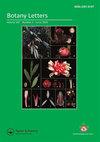四种卷柏属植物的叶片形态和表皮超微结构(卷柏科-石藻门)
IF 1.3
4区 生物学
Q3 PLANT SCIENCES
引用次数: 0
摘要
摘要南美洲亚热带卷柏属植物的叶片形态在结构和超微结构上存在差异,有助于物种鉴定。利用光学显微镜和扫描电子显微镜研究了卷柏、小叶卷柏、赛氏卷柏和沟状卷柏的气孔类型微形态、二氧化硅细胞、二氧化硅细胞和二氧化硅体的分布模式。观察到五种气孔类型,异常细胞型、放射线细胞型、不等细胞型、星形细胞型和四细胞型,以及另外两种变体,异常二细胞型和异常不透明细胞型。确定了五种二氧化硅细胞分布模式,即层状、内侧、内侧基底镜下、肋下和边缘下。首次描述了金字塔形二氧化硅体和凹底锥形体。在所研究的物种中,旋花S.convoluta的二氧化硅体是金字塔形的,小叶S.microphylla的二氧化硅体为球状、圆锥形和棱锥形的,而塞洛维S.sellowii和沟状S.sulcata的二氧化硅体则是圆锥形的,具有不同大小的凹基。介绍了表皮特征的说明、LM照片、SEM显微照片和对比表。本文章由计算机程序翻译,如有差异,请以英文原文为准。
Foliar morphology and epidermal ultrastructure of four Selaginella species (Selaginellaceae – Lycophyta)
ABSTRACT The leaf morphology of Selaginella species from subtropical South America show differences in structure and ultrastructure that are useful for species identification. We studied the following epidermal traits: micromorphology of stomatal types, distribution patterns of silica cells, silica cells and silica bodies of Selaginella convoluta, S. microphylla, S. sellowii and S. sulcata, using light and scanning electron microscopy. Five stomatal types were observed, anomocytic, actinocytic, anisocytic, staurocytic and tetracytic and two additional variants, anomodiacytic and anomoparacytic. Five silica cell distribution patterns were identified, laminar, medial, medial-basiscopic, subcostal, and submarginal. Pyramidal silica bodies and conical bodies with concave base are described for the first time. In the studied species, silica bodies are pyramidal in S. convoluta and globular, conical and pyramidal in S. microphylla, whereas in S. sellowii and S. sulcata they are conical, with concave base of different sizes. Illustrations of the epidermal features, LM photographs, SEM micrographs and comparative tables are presented.
求助全文
通过发布文献求助,成功后即可免费获取论文全文。
去求助
来源期刊

Botany Letters
Agricultural and Biological Sciences-Plant Science
CiteScore
3.10
自引率
6.70%
发文量
54
期刊介绍:
Botany Letters is an international scientific journal, published by the French Botanical Society (Société botanique de France) in partnership with Taylor & Francis. Botany Letters replaces Acta Botanica Gallica, which was created in 1993, building on over a century of renowned publications by the Société botanique de France.
 求助内容:
求助内容: 应助结果提醒方式:
应助结果提醒方式:


